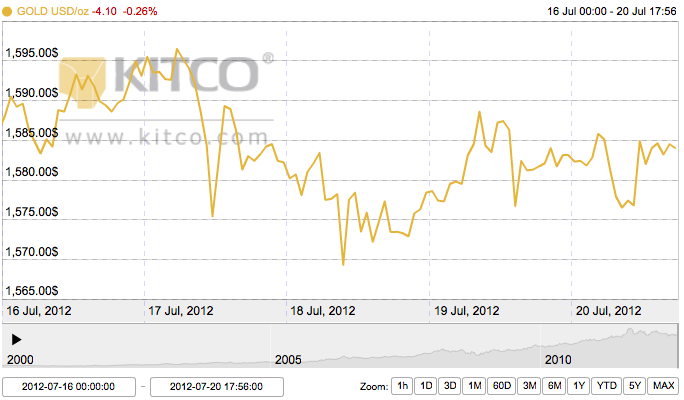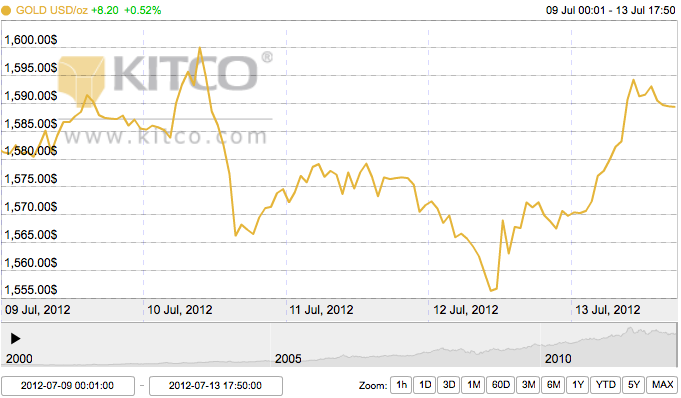Monday Open: $1,588.10
Weekly High: $1,596.50
Weekly Low: $1,569.30
Friday Close: $1,584.00
This week continued the typical holding pattern that gold has been experiencing since the beginning of the summer, following a few modest ups and downs but generally maintaining a steady balance, not straying not too far from $1,580 during this 5-day trading period. The major events of the week included anticipation of some change in Federal Reserve Chairman Ben Bernake’s economic policy, gains in the Indian rupee, a falling dollar and escalating conflicts in the Middle East.
Monday opened steady, with a weak dollar index, firm oil prices and news from China that their economy is still sluggish. Monday evening and Tuesday morning marked a slight rise in the price of gold to almost $1,600 (with some opting out of the market, as well), as bullish traders anticipated Bernake’s remarks on Tuesday afternoon. Despite the same story repeating itself over the past few months, where some clues indicate that Bernake may loosen U.S. economic restraints, thus burgeoning gold, he once again disappointed gold bulls on Tuesday with no concrete changes in financial policy. Compounding the disappointment was a slightly stronger dollar, and prices dropped to close lower on Tuesday.
Bernake spoke again on Wednesay, and true to pattern, said nothing on third quarter easing. Gold dropped slightly. Thursday revealed more weak U.S. economic data, spurring gold to climb back to its original state of around $1,580, and this foundation persisted through the end of the trading week. Friday saw slightly higher economic reports and a stronger dollar, but not enough to create a significant change in price.
Indian demand for gold is on the radar this week, as the rupee has been gaining strength and Indian traders, especially jewelers, are anticipating next month’s festival and wedding season. Gold is a tremendous part of Indian culture, especially special events and weddings, and though the rupee saw modest gains this week, Indian traders are still generally hanging out on the sidelines. Still, some analysts predict the price of gold to spike as much as 25% in the next month due to Indian demand.
In other news, a suicide bomber attacked a bus full of Israeli tourists in Bulgaria on Thursday, and late Wednesday, the Syrian defense minister was assassinated, heightening tensions in the Middle East. Any serious conflicts arising in the Middle East will likely spur a safety rush into gold, as well as increases in crude oil, which would also strengthen the precious metal.
With all these competing and mostly hypothetical factors influencing gold, the yellow metal seems to be stuck in a summer limbo. One report quoted Goldman Sachs as expecting gold to reach $1,840.00 per ounce in the next six months. As for now, traders are still waiting for U.S. policy changes, and Kitco’s weekly survey reported that participants are still pretty evenly split on the future of gold.

